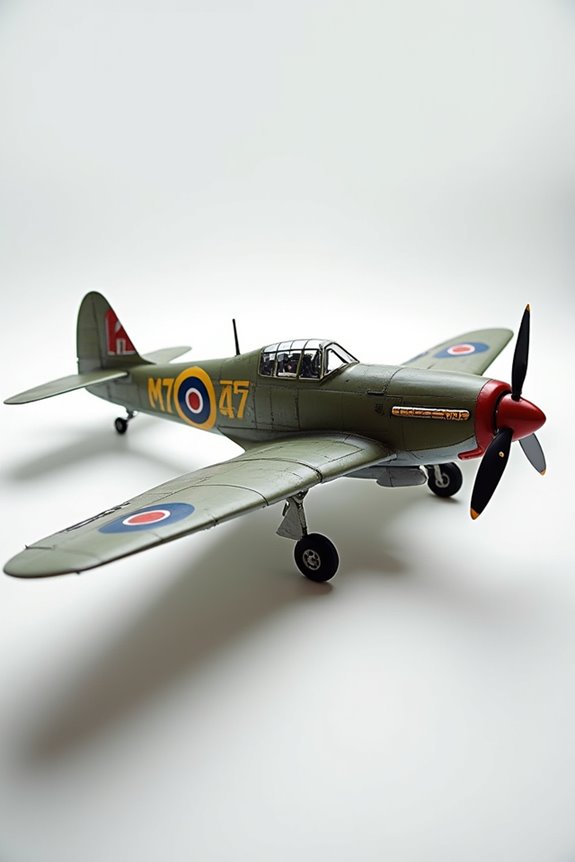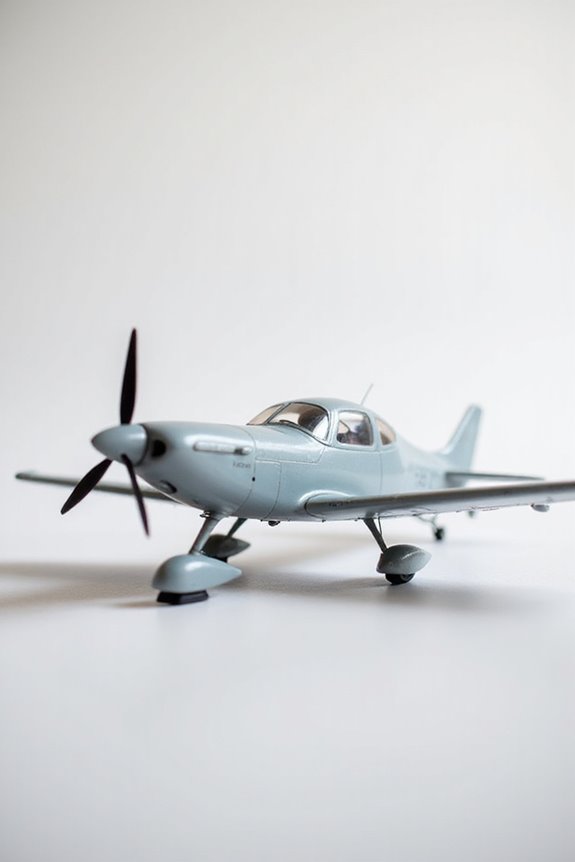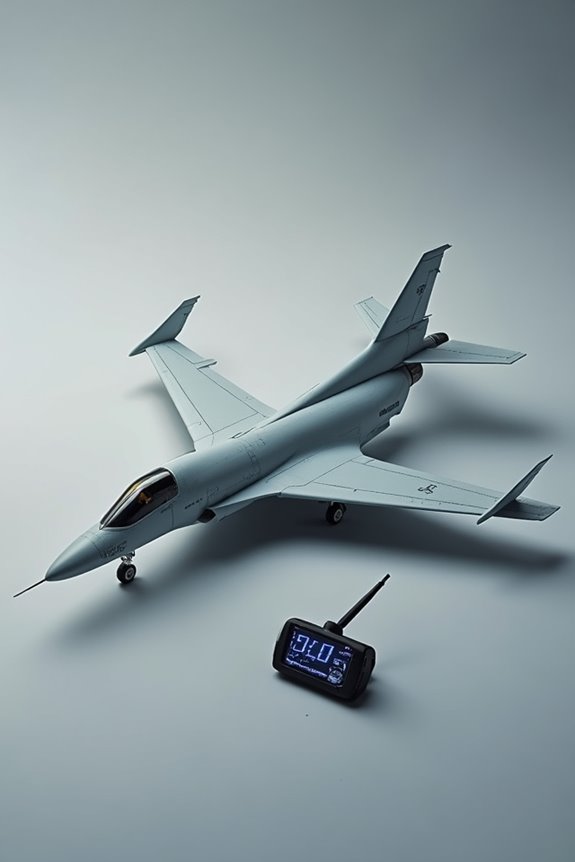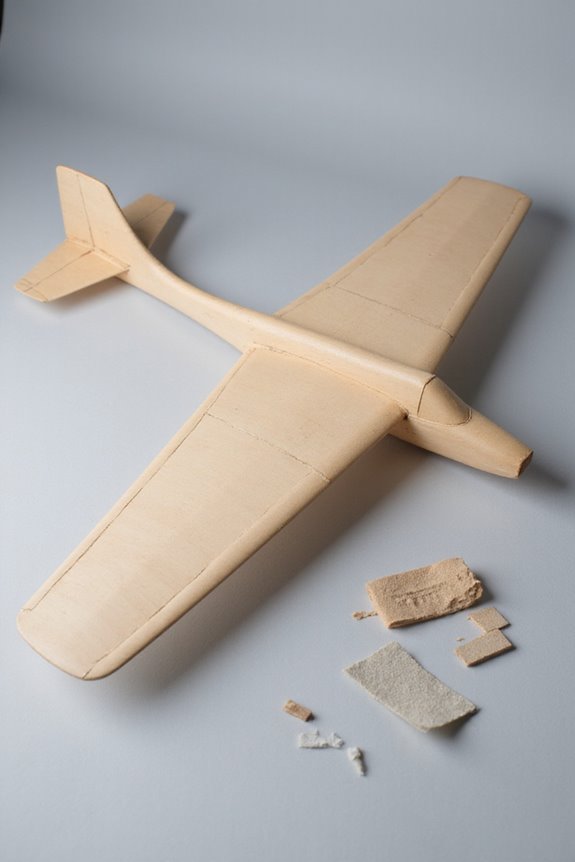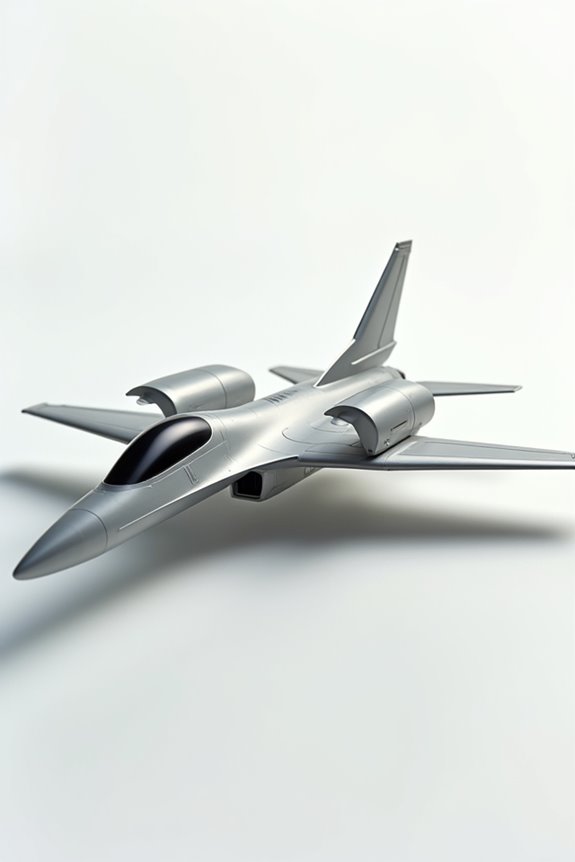To join the fun of model aircraft competitions, we need to get familiar with the rules and register our models. First, we must guarantee our planes are built from approved materials like balsa wood. Then, we sign up with the FAA if our models weigh over 0.55 pounds. Next, let’s get serious about safety and practice our flying skills to impress the judges. Ready to soar? There’s plenty more to uncover about this exciting hobby!
Key Takeaways
- Ensure eligibility by signing a declaration of model conformity and meeting age classification requirements: Junior, Senior, or Adult.
- Register your aircraft with the FAA if it weighs over 0.55 pounds, costing $5 for three years.
- Construct your model using approved materials like balsa wood, following guidelines for safety and aesthetics.
- Familiarize yourself with competition rules, including flight operations, safety procedures, and required certifications for events like pylon races.
- Join a local club to gain access to resources, organized events, and mentorship from experienced pilots to enhance your skills.
Understanding Competition Rules and Eligibility
How do we get started with model aircraft competitions? First off, we need to grasp the eligibility criteria, which often involves signing a declaration that our model conforms to specific rules. Don’t worry; it’s a little less intimidating than it sounds!
Owning the model is a must, with any previous ownership marks gone. Also, we might find ourselves classified by age: Junior, Senior, or Adult—just like school grades but way cooler!
Next, we need to familiarize ourselves with the competition rules. For instance, those pylon races require that we hold at least a Basic certificate to race our beauties. So, let’s gear up and make sure we’re ready to take to the skies!
Model Construction and Material Standards
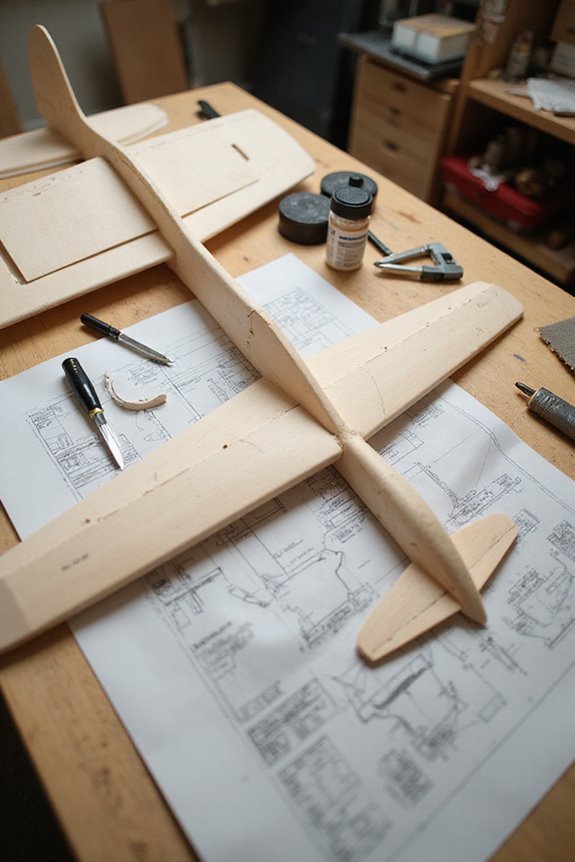
When we plunge into the world of model aircraft competitions, understanding construction and material standards is essential. The primary material we often choose is balsa wood, known for its lightweight and strength. Covering materials like Japanese tissue and silk really add a polished finish. But beware! Using prohibited materials like plastic films might send our models into disqualification territory.
When it comes to construction techniques, models typically need double covering on flying surfaces—unless we’re copying a slick prototype. Tail surfaces can be adjusted for stability without ruining the scale vibe. Also, let’s not forget securing payload compartments. This way, we keep our designs safe and simple, like securing candy in a piñata—no surprises allowed! Remember, a detailed documentation packet goes a long way. Additionally, many kits, such as Balsa Wood Airplane Kits, are designed for easy assembly, making them ideal for both beginners and experienced builders.
Registration, Classification, and Age Groups
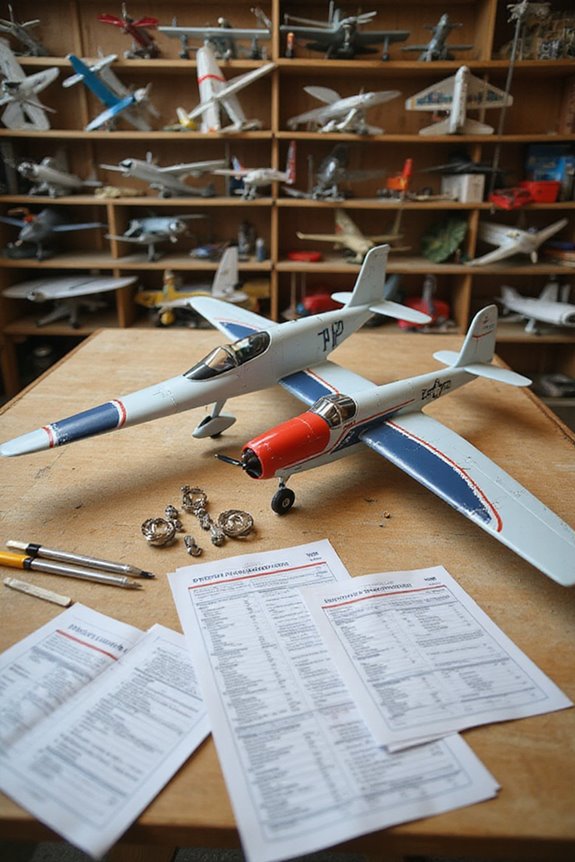
Before we immerse ourselves in the thrilling world of model aircraft competitions, it’s crucial to wrap our heads around some key concepts: registration, classification, and age groups. To compete, we need to register with the FAA if our aircraft weighs more than 0.55 pounds. It’s just $5 for three years—what a deal!
Next, let’s talk about classification and the fun age divisions. Competitions often group participants by ages like Youth, Junior, Adult, and Senior. This guarantees fair play and makes it easier for everyone to shine. The Youth division, for example, encourages beginners to take flight with simplified categories. So, let’s gear up—registration is just the starting point for our new adventure in model aviation!
Flight Operations and Submission Procedures
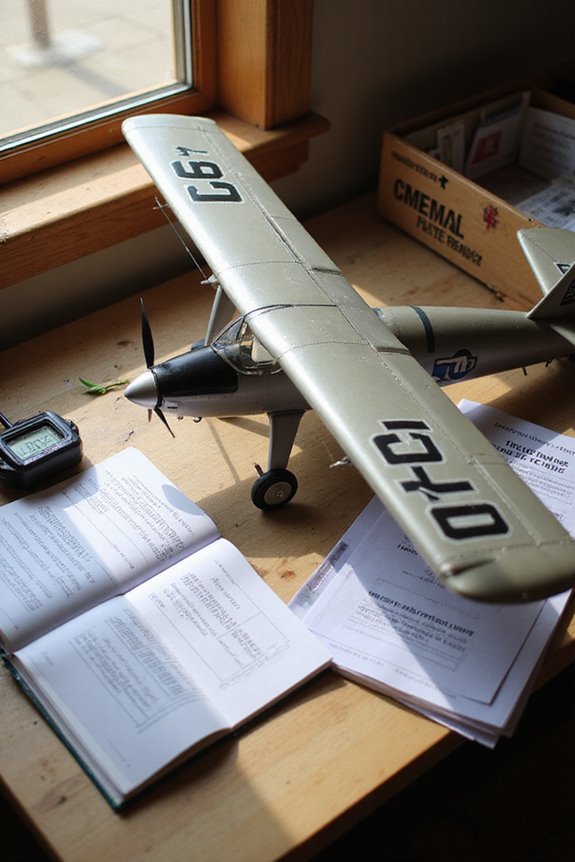
As we plunge into the nitty-gritty of flight operations and submission procedures, it’s essential to remember that preparation is half the battle. First, we need to guarantee our models pass all safety checks and are airworthy before flight. Once on the field, we’ll want to clear the area of any obstructions and onlookers—nobody wants an unexpected “oops” moment!
Flight timing is vital; we usually get one official flight per round, so let’s make it count. Each aircraft has specific launch methods, whether it’s hand-launching or towline. If our flight lasts at least 20 seconds, we score! If not, it’s a non-scoring attempt. Let’s put our best wing forward and soar through these competitions together! Additionally, having a reliable gyro stabilization system can significantly enhance your flying performance during competitions.
Preparing for Competition Participation
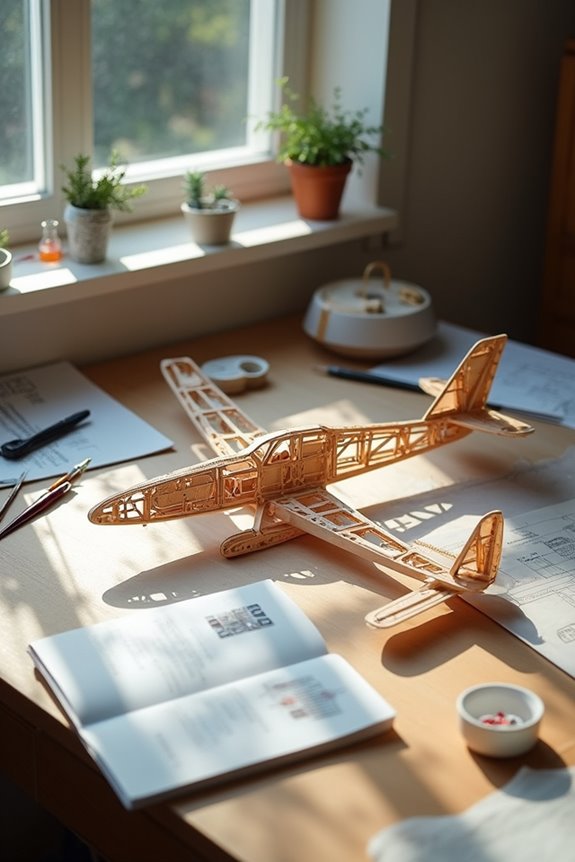
Getting ready for competition participation can feel like tuning a finely calibrated engine—every little detail matters! We need to embrace a competition mindset, which means practicing those flight routines until they become second nature. Researching our aircraft’s historical nuances gives us authenticity, making our presentation stand out.
Let’s gather detailed specs on speeds and unique maneuvers to impress the judges. High-quality materials and fine-tuned assembly help guarantee our models perform flawlessly. Multiple test flights under various conditions will shed light on performance strengths and weaknesses. Remember, a solid checklist can be our best friend! With focused practice and keen attention to detail, we’ll bring our models to life in a spectacular way. Additionally, understanding the importance of build complexity and material durability will further enhance our preparation. Now, let’s get out there and fly like the wind!
Key Regulatory Bodies and Rule Resources
When it comes to model aircraft competitions, understanding the key regulatory bodies and rule resources is crucial—it’s like knowing the rules of the road before we take off! The Fédération Aéronautique Internationale (FAI) oversees everything globally. In the U.S., we have the Academy of Model Aeronautics (AMA), while the UK relies on the British Model Flying Association (BMFA).
These organizations provide essential rulebooks and contest resources, helping us navigate compliance challenges. They also deliver regulatory updates as laws change, keeping us safely in the air. Plus, they guarantee we follow rules about pilot registration and altitude limits. So, before we launch, let’s get familiar with what’s required to compete and avoid any surprises—no one likes a mid-air headache!
Building and Modifying Your Model
Now that we’ve got a grip on the regulatory rules, let’s shift gears and talk about building and modifying your model—that’s where the real fun begins! We should stick primarily to lightweight materials, like balsa wood, and use tissue paper for covering. No plastic films, folks!
When it comes to building techniques, creativity takes flight. We can tweak tail surfaces slightly for scale accuracy but must keep it true to the original aircraft. Modifying components, like adding internal ballast, helps with balance while complying with weight limits. Just remember, we’ve gotta prove we did the building ourselves—we can’t just play with pre-made parts! So, let’s grab our tools and get crafting, because our masterpieces await! Additionally, using high-grade materials ensures durability and enhances the overall performance of your model.
Safety Considerations During Competition
Safety is key in model aircraft competitions, and following some essential guidelines can make all the difference. We need to stick to strict safety protocols to protect ourselves and those around us. For example, only those flying should be in front of the safety line. Keeping flights under 400 feet near airports is crucial to avoid airspace conflicts.
When it comes to handling our models, we must make sure they’re in top shape with no sharp edges or damaged parts. Plus, let’s keep our flying away from people and vehicles. And don’t forget about emergency procedures; being aware of our surroundings helps us react quickly if something goes wrong. With these precautions, we can soar high without a worry!
Tips for Success in Model Aircraft Competitions
Competing in model aircraft events isn’t just about flying; it’s a blend of creativity, precision, and strategy. We need a solid competition mindset, focusing on mastering the rules and judging criteria. Understanding the design specifications is essential—size, weight, and modifications can make or break our chances.
Let’s choose models suited to our skill level, preferably those known for reliability. Precision construction is key. Every part should fit seamlessly; no one likes a model that looks thrown together!
We can’t forget practice—know every maneuver like the back of our hands. A good flight routine is like a dance; our performance evaluation relies on it! Finally, let’s present our models with a professional finish and confidence. Who doesn’t love a sparkling aircraft? Additionally, selecting planes with flight stability features can enhance our performance and control during competitions.
Networking and Community Engagement
Building connections in the model aircraft community can elevate our flying game to new heights. Joining a local club gives us access to flying sites, experienced pilots, and organized events. Regular meetings help us network and learn from each other. Plus, many clubs have show teams for public demonstrations, acting like our very own hype squad for competitions!
Community outreach is essential, too. We can participate in events that raise awareness and attract newcomers. Fundraisers not only support our clubs but also allow us to collaborate and share resources for competitions. Whether it’s through youth programs or public displays, engaging with our community fosters those valuable connections. Remember, every friend we make is a potential co-pilot on our journey to the skies!
Frequently Asked Questions
What Should I Wear During Model Aircraft Competitions?
Like a well-oiled machine, our competition attire needs to fit the occasion. We should consider the weather—official shirts and gray bottoms are necessary, but layers may enhance comfort during outdoor events.
How Do I Find Competition Locations Near Me?
To find competition locations near us, we can check local clubs for event listings and utilize online forums to discover new opportunities. Staying active in these spaces keeps us updated on upcoming competitions and venues.
Can I Use My Smartphone During the Competition?
We recognize you’re curious about smartphone use during competitions. Following proper smartphone etiquette is essential, as competition rules generally limit use to outside flight times, ensuring we stay focused and avoid distractions while flying.
What Happens if My Model Crashes During the Event?
If our model crashes during an event, we must quickly assess damage and consider crash recovery strategies. Plus, having competition insurance in place can protect us against potential losses from repairs or disqualifications.
Are There Age Restrictions for Spectators at Competitions?
When attending competitions, we must follow spectator rules for safety. It’s crucial to respect competition etiquette by keeping children within designated areas, ensuring everyone enjoys the event without risking accidents or distractions to pilots.

